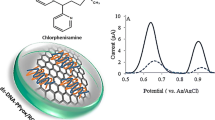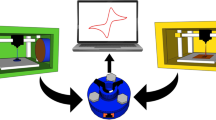Abstract
A laser-scribed graphene (LSG) device fabricated on polymeric polyetherimide (PEI) substrate is reported for sensitive electrochemical detection of xylazine (XLZ), a veterinary drug that has been associated with drug-facilitated crimes. Morphological characterization was made by scanning electron microscopy (SEM), demonstrating that the electrochemical device presents a highly porous carbonaceous structure. In addition, Raman spectroscopy, Fourier-transform infrared spectroscopy (FTIR), wettability, electrochemical impedance spectroscopy (EIS), and cyclic voltammetry (CV) measurements were used to characterize the PEI-LSG material, which showed superior electroanalytical performance after a simple anodic treatment in an alkaline medium (applying 2 V for 120 s in 0.1 mol L−1 NaOH solution). The electrochemical determination of XLZ was carried out using square wave voltammetry (SWV), which showed sensitivity and coefficient of determination (R2) equal to 0.206 ± 0.008 A L mol−1 cm−2 and 0.991, respectively. In addition, we obtained a low limit of detection (LOD) of 1.39 × 10−7 mol L−1 with a linear response in the concentration range 5.0 to 200.0 × 10−6 mol L−1. The PEI-LSG electrochemical sensor was applied to XLZ detection in commercial beverage and synthetic urine samples, providing recoveries between 96.0 and 114.8%. Collectively, our electrochemical sensor presents an easy method to manufacture reproducible (relative standard deviation (RSD) of 2.56%), low-cost ($0.12), and single-use (disposable) devices, which is a promising way for in-field determination of drug-facilitated sexual assaults and other relevant applications.
Graphical Abstract





Similar content being viewed by others
References
Choi H, Nguyen PT, Bin IJ (2019) Laser transmission welding and surface modification of graphene film for flexible supercapacitor applications. Appl Surf Sci 483:481–488. https://doi.org/10.1016/j.apsusc.2019.03.349
Peng Z, Ye R, Mann JA et al (2015) Flexible boron-doped laser-induced graphene microsupercapacitors. ACS Nano 9:5868–5875. https://doi.org/10.1021/acsnano.5b00436
Mendes LF, de Siervo A, Reis de Araujo W, Longo Cesar Paixão TR (2020) Reagentless fabrication of a porous graphene-like electrochemical device from phenolic paper using laser-scribing. Carbon N Y 159:110–118. https://doi.org/10.1016/j.carbon.2019.12.016
Rauf S, Lahcen AA, Aljedaibi A et al (2021) Gold nanostructured laser-scribed graphene: A new electrochemical biosensing platform for potential point-of-care testing of disease biomarkers. Biosens Bioelectron 180:1–9. https://doi.org/10.1016/j.bios.2021.113116
Torres AM, Id CLG, Id ESM (2018) Laser scribed graphene biosensor for detection of biogenic amines in food samples using locally sourced materials. Biosensors 8:1–19. https://doi.org/10.3390/bios8020042
Liberato S De, Ciuti C, Auston D et al (2012) Laser scribing of high-performance and flexible graphene-based electrochemical capacitors. Science (80- ) 335:1326–1331. https://doi.org/10.1126/science.121674
Lin J, Peng Z, Liu Y et al (2014) Laser-induced porous graphene films from commercial polymers. Nat Commun 5:5–12. https://doi.org/10.1038/ncomms6714
Peng Z, Lin J, Ye R et al (2015) Flexible and stackable laser-induced graphene supercapacitors. ACS Appl Mater Interfaces 7:3414–3419. https://doi.org/10.1021/am509065d
Han X, Ye R, Chyan Y et al (2018) Laser-induced graphene from wood impregnated with metal salts and use in electrocatalysis. ACS Appl Nano Mater 1:5053–5061. https://doi.org/10.1021/acsanm.8b01163
Singh SP, Li Y, Zhang J et al (2018) Sulfur-doped laser-induced porous graphene derived from polysulfone-class polymers and membranes. ACS Nano 12:289–297. https://doi.org/10.1021/acsnano.7b06263
Zhang N, Yang J, Hu C (2022) Laser-scribed graphene sensors on nail polish with tunable composition for electrochemical detection of nitrite and glucose. Sensors Actuators B Chem 357:131–139. https://doi.org/10.1016/j.snb.2022.131394
de Araujo WR, Frasson CMR, Ameku WA et al (2017) Single-step reagentless laser scribing fabrication of electrochemical paper-based analytical devices. Angew Chemie 129:15309–15313. https://doi.org/10.1002/ange.201708527
Getachew BA, Bergsman DS, Grossman C (2020) Laser-induced graphene from polyimide and polyethersulfone precursors as a sensing electrode in anodic stripping voltammetry. ACS Nano 12:289–297. https://doi.org/10.1021/acsami.0c11725
de Araujo WR, Frasson CMR, Ameku WA et al (2017) Single-step reagentless laser scribing fabrication of electrochemical paper-based analytical devices. Angew Chemie Int Ed 56:15113–15117. https://doi.org/10.1002/anie.201708527
Wahab H, Jain V, Tyrrell AS et al (2020) Machine-learning-assisted fabrication: Bayesian optimization of laser-induced graphene patterning using in-situ Raman analysis. Carbon N Y 167:609–619. https://doi.org/10.1016/j.carbon.2020.05.087
Mendes LF, Pradela-Filho LA, Paixão TRLC (2022) Polyimide adhesive tapes as a versatile and disposable substrate to produce CO2 laser-induced carbon sensors for batch and microfluidic analysis. Microchem J 182:107893. https://doi.org/10.1016/j.microc.2022.107893
Han GH, Chae SJ, Kim ES et al (2011) Laser thinning for monolayer graphene formation: heat sink and interference effect. ACS Nano 5:263–268. https://doi.org/10.1021/nn1026438
de Lima LF, Pereira EA, Ferreira M (2020) Electrochemical sensor for propylparaben using hybrid layer-by-layer films composed of gold nanoparticles, poly(ethylene imine) and nickel(II) phthalocyanine tetrasulfonate. Sensors Actuators, B Chem 310:1–8. https://doi.org/10.1016/j.snb.2020.127893
de Lima LF, Ferreira AL, Torres MDT et al (2021) Minute-scale detection of SARS-CoV-2 using a low-cost biosensor composed of pencil graphite electrodes. Proc Natl Acad Sci U S A 118:1–9. https://doi.org/10.1073/pnas.2106724118
Mendes LF, Souza e Silva ÂR, Bacil RP et al (2019) Forensic electrochemistry: electrochemical study and quantification of xylazine in pharmaceutical and urine samples. Electrochim Acta 295:726–734. https://doi.org/10.1016/j.electacta.2018.10.120
Ferreira PC, Ataíde VN, Silva Chagas CL et al (2019) Wearable electrochemical sensors for forensic and clinical applications. TrAC Trends Anal Chem 119:1–16. https://doi.org/10.1016/j.trac.2019.115622
de Lima LF, Daikuzono CM, Miyazaki CM et al (2020) Layer-by-layer nanostructured films of magnetite nanoparticles and polypyrrole towards synergistic effect on methylparaben electrochemical detection. Appl Surf Sci 505:1–9. https://doi.org/10.1016/j.apsusc.2019.144278
De Lima LF, Maciel CC, Ferreira AL et al (2020) Nickel (II) phthalocyanine-tetrasulfonic-Au nanoparticles nanocomposite film for tartrazine electrochemical sensing. Mater Lett 262:1–5. https://doi.org/10.1016/j.matlet.2019.127186
Karimi-Maleh H, Karimi F, Alizadeh M, Sanati AL (2020) Electrochemical sensors, a bright future in the fabrication of portable kits in analytical systems. Chem Rec 20:682–692. https://doi.org/10.1002/tcr.201900092
Nunez J, DeJoseph ME, Gill JR (2021) Xylazine, a veterinary tranquilizer, detected in 42 accidental fentanyl intoxication deaths. Am J Forensic Med Pathol 42:9–11. https://doi.org/10.1097/PAF.0000000000000622
Ruiz-Colo K, Martınez MA, Silva-Torres LA, Chavez-Arias C, Melendez-Negro M, Conte-Miller MS, Bloom-Oquendo J (2012) Simultaneous determination of xylazine, free morphine, codeine, 6-acetylmorphine, cocaine and benzoylecgonine in postmortem blood by UPLC – MS-MS. J Anal Toxicol 36:319–326. https://doi.org/10.1093/jat/bks024
Morgan JM, Ross MW, Levine DG et al (2020) Effects of acepromazine and xylazine on subjective and objective assessments of forelimb lameness. Equine Vet J 52:593–600. https://doi.org/10.1111/evj.13225
Johnson J, Pizzicato L, Johnson C, Viner K (2021) Increasing presence of xylazine in heroin and/or fentanyl deaths, Philadelphia, Pennsylvania, 2010–2019. Inj Prev 27:395–398. https://doi.org/10.1136/injuryprev-2020-043968
Bowles JM, McDonald K, Maghsoudi N et al (2021) Xylazine detected in unregulated opioids and drug administration equipment in Toronto, Canada: clinical and social implications. Harm Reduct J 18:1–6. https://doi.org/10.1186/s12954-021-00546-9
Zheng X, Mi X, Li S, Chen G (2013) Determination of xylazine and 2,6-xylidine in animal tissues by liquid chromatography-tandem mass spectrometry. J Food Sci 78:T955–T959. https://doi.org/10.1111/1750-3841.12144
Hoffmann U, Meister CM, Golle K, Zschiesche M (2001) Severe intoxication with the veterinary tranquilizer xylazine in humans. J Anal Toxicol 25:245–249. https://doi.org/10.1093/jat/25.4.245
Andresen-Streichert H, Iwersen-Bergmann S, Mueller A, Anders S (2017) Attempted drug-facilitated sexual assault—xylazine intoxication in a child. J Forensic Sci 62:270–273. https://doi.org/10.1111/1556-4029.13270
Ruiz-Colon K, Chavez-Arias C, Daz-Alcala JE, Martınez MA (2014) Xylazine intoxication in humans and its importance as an emerging adulterant in abused drugs : a comprehensive review of the literature. Forensic Sci Int 240:1–8. https://doi.org/10.1016/j.forsciint.2014.03.015
Saisahas K, Soleh A, Promsuwan K et al (2021) Journal of pharmaceutical and biomedical analysis a portable electrochemical sensor for detection of the veterinary drug xylazine in beverage samples. J Pharm Biomed Anal 198:113958. https://doi.org/10.1016/j.jpba.2021.113958
Saisahas K, Soleh A, Promsuwan K et al (2022) Nanocoral-like polyaniline-modified graphene-based electrochemical paper-based analytical device for a portable electrochemical sensor for xylazine detection. ACS Omega 7:13913–13924. https://doi.org/10.1021/acsomega.2c00295
Kavai MS, de Lima LF, de Araujo WR (2023) A disposable and low-cost laser-scribed graphene electrochemical sensor for simultaneous detection of hydroquinone, paracetamol and methylparaben. Mater Lett 330:133211. https://doi.org/10.1016/j.matlet.2022.133211
Monteiro MKS, Santos ECMM, Silva DR et al (2020) Simultaneous determination of paracetamol and caffeine in pharmaceutical formulations and synthetic urine using cork-modified graphite electrodes. J Solid State Electrochem 24:1789–1800. https://doi.org/10.1007/s10008-020-04722-y
Camargo JR, Andreotti IAA, Kalinke C et al (2020) Waterproof paper as a new substrate to construct a disposable sensor for the electrochemical determination of paracetamol and melatonin. Talanta 208:1–8. https://doi.org/10.1016/j.talanta.2019.120458
Naim R, Ismail AF, Matsuura T, Rudaini IA (2018) Polyetherimide hollow fiber membranes for CO2 absorption and stripping in membrane contactor application. RSC Adv 8:3556–3563. https://doi.org/10.1039/c7ra12045a
Taherian F, Marcon V, Van Der VNFA (2013) What is the contact angle of water on graphene ? Langmuir 29:1457–1465. https://doi.org/10.1021/la304645w
Dervishi E, Ji Z, Htoon H et al (2019) Raman spectroscopy of bottom-up synthesized graphene quantum dots: Size and structure dependence. Nanoscale 11:16571–16581. https://doi.org/10.1039/c9nr05345j
Basu S, Heuchel M, Weigel T et al (2015) Integrated process for preparing porous, surface functionalized polyetherimide microparticles. Polym Adv Technol 26:1447–1455. https://doi.org/10.1002/pat.3684
Silverstein RM, Bassler GC (1962) Spectrometric identification of organic compounds. J Chem Educ 39(11):546. https://doi.org/10.1021/ed039p546
Bard AJ, Faulkner LR, White HS (2001) Electrochemical methods: fundamentals and applications, 2nd edn. John Wiley & Sons
El-Shal MA, Hendawy HAM (2019) Highly sensitive voltammetric sensor using carbon nanotube and an ionic liquid composite electrode for xylazine hydrochloride. Anal Sci 35:189–194. https://doi.org/10.2116/analsci.18P368
Niedorf F, Bohr HH, Kietzmann M (2003) Simultaneous determination of ketamine and xylazine in canine plasma by liquid chromatography with ultraviolet absorbance detection. J Chromatogr B Anal Technol Biomed Life Sci 791:421–426. https://doi.org/10.1016/S1570-0232(03)00215-0
Spyridaki MH, Lyris E, Georgoulakis I et al (2004) Determination of xylazine and its metabolites by GC-MS in equine urine for doping analysis. J Pharm Biomed Anal 35:107–116. https://doi.org/10.1016/j.jpba.2003.12.007
Jones R, Ryan AJ, Wright SE (1964) The metabolism and excretion of tartrazine in the rat, rabbit and man. Food Cosmet Toxicol 2:447–452. https://doi.org/10.1016/S0015-6264(64)80287-X
Garbin R, Bogusz Junior S, Montano MA (2005) Níveis de cobre em amostras de cachaça produzidas na região noroeste do Rio Grande do Sul, Brasil. Ciência Rural 35:1436–1440. https://doi.org/10.1590/s0103-84782005000600033
de Lima LF, Ferreira AL, Maciel CC et al (2021) Disposable and low-cost electrochemical sensor based on the colorless nail polish and graphite composite material for tartrazine detection. Talanta 227:122200. https://doi.org/10.1016/j.talanta.2021.122200
Galant AL, Kaufman RC, Wilson JD (2015) Glucose: detection and analysis. Food Chem 188:149–160. https://doi.org/10.1016/j.foodchem.2015.04.071
Zulueta A, Esteve MJ, Frígola A (2010) Ascorbic acid in orange juice-milk beverage treated by high intensity pulsed electric fields and its stability during storage. Innov Food Sci Emerg Technol 11:84–90. https://doi.org/10.1016/j.ifset.2009.07.007
Acknowledgements
The authors would like to thank Servier Medical Art for help with some images, Hugo Campos Loureiro for morphological characterization, and Amanda S. M. de Freitas for the wettability measurements.
Funding
This work was supported by the São Paulo Research Foundation (FAPESP) [grant number: 2018/08782–1], CNPq (grant number: 438828/2018–6), and CAPES (grant number: 88887.479793/2020–00).
Author information
Authors and Affiliations
Corresponding author
Ethics declarations
Conflict of interest
The authors declare no competing interests.
Additional information
Publisher's note
Springer Nature remains neutral with regard to jurisdictional claims in published maps and institutional affiliations.
Supplementary Information
Below is the link to the electronic supplementary material.
Rights and permissions
Springer Nature or its licensor (e.g. a society or other partner) holds exclusive rights to this article under a publishing agreement with the author(s) or other rightsholder(s); author self-archiving of the accepted manuscript version of this article is solely governed by the terms of such publishing agreement and applicable law.
About this article
Cite this article
de Lima, L.F., de Araujo, W.R. Laser-scribed graphene on polyetherimide substrate: an electrochemical sensor platform for forensic determination of xylazine in urine and beverage samples. Microchim Acta 189, 465 (2022). https://doi.org/10.1007/s00604-022-05566-1
Received:
Accepted:
Published:
DOI: https://doi.org/10.1007/s00604-022-05566-1




